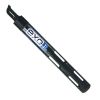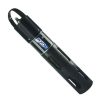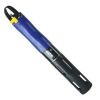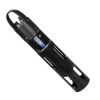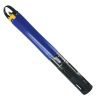YSI EXO Conductivity & Temperature Sensor
Features
- 0 to 200 mS/cm measurement range
- T63<2 sec response time
- ±0.5% of reading or 0.001 mS/cm accuracy from 0 to 100
- Free ground shipping
- Expedited repair and warranty service
- Lifetime technical support
- More
Overview
The YSI EXO conductivity & temperature sensor is a digital smart sensor featuring welded titanium construction and wet-mateable connectors. The sensor provides accurate and fast temperature data and enables temperature compensation for other EXO probes. Conductivity data is used to calculate salinity, non-linear function (nLF) conductivity, specific conductance, and total dissolved solids, and compensate for changes in the density of water (as a function of temperature and salinity) in depth calculations if a depth sensor is installed.
Temperature Thermistor
The temperature sensor uses a highly stable and aged thermistor with low-drift characteristics. The thermistor’s resistance changes with temperature. The measured resistance is then converted to temperature using an algorithm. The temperature sensor receives a multi-point NIST traceable wet calibration, and the accuracy specification of 0.01˚C is valid for the expected life of the probe. No calibration or maintenance of the temperature sensor is required, but accuracy checks can be conducted.
Conductivity Electrodes
The conductivity sensor uses four internal, pure-nickel electrodes to measure solution conductance. Two of the electrodes are current-driven, and two are used to measure the voltage drop. The measured voltage drop is then converted into a conductance value in milliSiemens (millimhos). To convert this value to a conductivity value in milliSiemens per cm (mS/cm), the conductance is multiplied by the cell constant that has units of reciprocal cm (cm-1). The cell constant for the conductivity cell is approximately 5.5/cm ±10%. For most applications, the cell constant is automatically determined (or confirmed) with each deployment of the system when the calibration procedure is followed.
Temperature Compensation
EXO sensors have internal thermistors for quality assurance purposes. Turbidity uses the internal thermistor for temperature compensation, while all other EXO sensors reference the C/T probe for temperature compensation. To display and log temperature, a C/T probe must be installed in an EXO sonde. Thermistor readings are logged in the sonde’s raw data–viewable in KOR software–but are not included in data exported to Excel.
In The News
YSI EXO3s: The Latest in Water Quality Monitoring
The YSI EXO3s offers the latest in multi-parameter water quality monitoring equipment that has a comprehensive list of smart sensors. With an external power source, this sonde is a cost-effective, compact EXO that has the same capabilities as the EXO3 . The sonde is built to last with resilient materials and backed with vigorous testing. The device has five ports for available YSI EXO smart sensors or central wiper. It seamlessly integrates with a data logger to collect and push valuable data to the cloud for access from a PC or mobile device. This small sonde is exceptional for both sampling and continuous monitoring applications.
Read MoreFloating Global New Ideas: Buoy-Enabled Research at Florida Agricultural and Mechanical University’s School of the Environment
Florida Agricultural and Mechanical University (FAMU), based in Tallahassee, Florida, is the highest-rated public Historically Black College or University in the United States. FAMU’s School of the Environment (FAMU-SOE) offers BS and BA degrees in Environmental Studies, and BS, MS, and Ph.D. degrees in Environmental Science, with specialisms available in areas including Environmental Policy and Risk Management, Aquatic and Terrestrial Ecology, and Biomolecular Sciences. In 2021, FAMU-SOE deployed a NexSens CB-450 buoy in Apalachee Bay, a key oyster farming area around 30 miles south of Tallahassee. The buoy has quickly been incorporated into the curriculum, providing environmental insights for student research, the community, and beyond. Dr.
Read MoreMonitoring Habitat Suitability and Water Quality in Northwest Arkansas Springs
Northwest Arkansas has seen an economic, industrial, and population boom in recent years as a result of expanding businesses, which have created thousands of jobs in the region and the mass migration of employees and construction companies. However, with this growth has come rapid urbanization and the degradation of the natural landscape, specifically the freshwater springs that can be found throughout the region. These springs are critical habitat centers for native wildlife, home to threatened and endangered fish, and those that have yet to be listed. Zach Moran, Assistant Professor of Fisheries Science at Arkansas Technical University, is working to help monitor these habitats and provide key data that will hopefully inform future development in the region.
Read More










